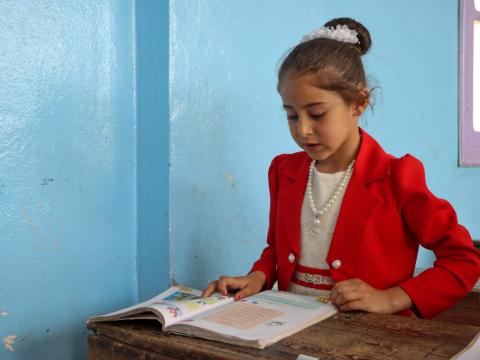13 years of the Syria crisis and still underfunded

In the context of the Brussels VIII Conference on “Supporting the future of Syria and the region”, Hamzah Barhameyeh, Advocacy and Communications Manager at World Vision Syria Response, and Allegra Ingenito, Junior Policy Officer at World Vision EUREP, outline the current situation in Syria and provide some recommendations to the EU policymakers.
The Syria crisis is the largest displacement crisis in the world, with over 12 million Syrians forcibly displaced in the Middle East region. 13 years of conflict, coupled with the consequences of the COVID-19 pandemic, cholera outbreaks and the recent earthquake, increased even more the humanitarian needs of Syrians, both within Syria and in the neighbouring host countries where many Syrian refugees now live.
Despite all the clear growing needs of Syrians, funding keeps decreasing. Only 6 per cent of the required funding for 2024 ($227 million of the $4.07 billion needed) has been received. This is resulting in drastic reductions in essential services such as food assistance and healthcare, severely affecting millions of Syrians.
Food insecurity and malnutrition
We are deeply concerned about food insecurity and malnutrition and the overall impact of climate change on internally displaced, refugees and vulnerable host populations.
As this recently published policy brief shows, In Syria alone, the World Food Programme (WFP) estimates that over 12.9 million Syrians are struggling with inadequate food supplies, while another 2.6 million are on the brink of food insecurity. Women and children are bearing the brunt of the food crisis in Syria: female-headed households are facing high levels of food insecurity that are exposing them to increased risks of gender-based violence, exploitation and abuse. Nearly 5.9 million people, 64% of whom are children, require immediate nutritional support, and stunting rates continue to rise.
Food insecurity is also raising concerns for both Syrians and local populations in neighbouring countries: Lebanon, Jordan, Iraq and Türkiye. In Lebanon, where 1.4 million Lebanese and non-Lebanese individuals face high levels of acute food insecurity, with rising inflation being a major driving factor. In Jordan, 18% of Syrian households face severe food insecurity and 27% report challenges in affording food.
In Iraq, climate change is the biggest threat to its long-term food security, causing dietary impacts, including reduced nutritional diversity, which in turn impacts children and young people’s physical growth and overall well-being. In Türkiye, while hunger is not a widespread issue, the prevalent consumption of unhealthy foods, together with limited access to nutritious options, is contributing to rising rates of poor nutrition and obesity among specific population groups.
World Vision is particularly active in the region to address these challenges. In 2023 alone, World Vision Syria Response (WVSR) reached close to 535,500 individuals in Northern Syria through its nutrition programs, including more than 329,000 children.
Education
On 30 April, World Vision Syria Response had a seat at the table at the Day of Dialogue for Syria in Brussels to speak about Education in Emergencies.
The protracted crisis in Syria continues to impact the education system negatively. Also, over 2.5 million children are out of school and another million are at risk of dropping out, increasing their vulnerability to gender protection risks, including child marriage and early pregnancy.
The longer children remain out of school, the less likely they are ever to return.
Thirteen years of crisis have physically hindered access to education, as schools have been used as temporary shelters during sudden displacements, are overcrowded and lack essential infrastructure such as adequate furniture, school supplies, and operational WASH facilities.
There is a significant shortage of qualified teachers, exacerbated by high transport costs and irregular payment schedules, especially in rural areas. Despite all of that, the education cluster in Syria is the most underfunded one.
To face this situation, World Vision Syria Response is focusing on enhancing cooperation and collaboration with different stakeholders, especially local partners, adopting integrated approaches, including innovative educational programmes, capacity-building sessions and local empowerment. An example of this is the LIFT (Life in Fulness Together) project, an initiative that combines education, psychosocial support, and child protection, aimed at fostering comprehensive child well-being, focusing in particular on the most vulnerable groups.
Recommendations
Ahead of the Ministerial Segment in Brussels on the Syria Conference, EU donors must step up their efforts to support Syrian families and children following 13 years of conflict. This means renewing their financial commitments on a multi-annual and flexible basis. They must focus on longer-term food security interventions, beyond emergency or short-term food assistance, in Syria and host countries, that would pave the way for more sustainable solutions to the current food security and nutrition crisis in the region. There is also a clear need for economic recovery and livelihood support initiatives alongside food assistance efforts to foster resilience and stability in Syria and the region.
Hamzah Barhameyeh, Advocacy and Communications Manager at World Vision Syria Response, and Allegra Ingenito, Junior Policy Officer at World Vision EUREP